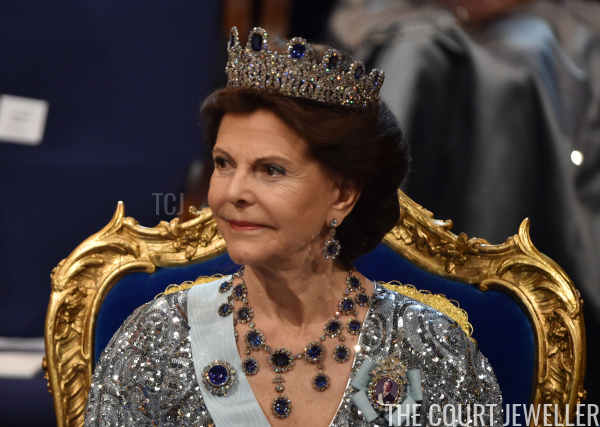 |
| Queen Silvia wears the Leuchtenberg sapphires at the Nobels, December 2016 (Pascal Le Segretain/Getty Images) |
Our journey through royal sapphire collections is stopping today in Stockholm, where we’ve got an updated, in-depth look at the history of one of the grandest sapphire parures of all: the Leuchtenberg Sapphires.
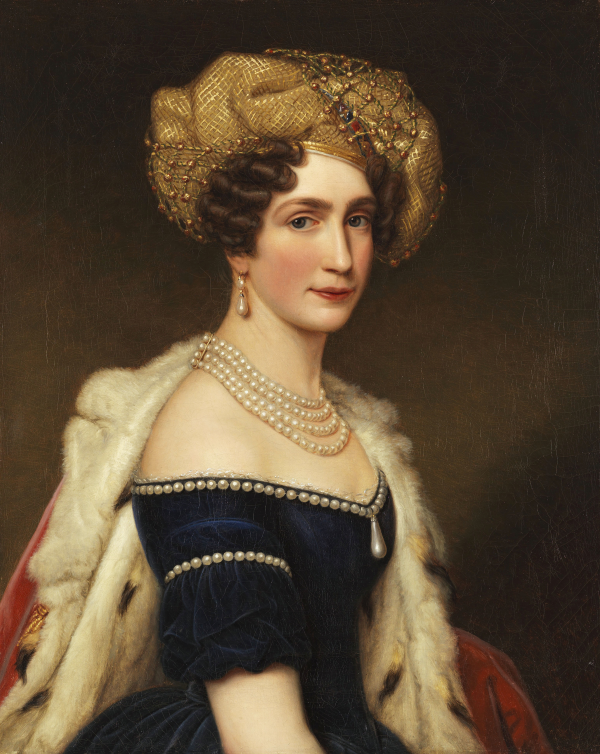 |
| Princess Augusta, Duchess of Leuchtenberg, painted by Joseph Karl Stieler, ca. 1825 (Wikimedia Commons) |
The parure’s first owner was Princess Augusta of Bavaria, the wife of Eugène de Beauharnais, the only son of Empress Joséphine of France. (Augusta’s father, King Maximilian I Joseph of Bavaria, later bestowed the Leuchtenberg ducal title on his son-in-law, hence the parure’s name.) For years, many speculated that Augusta had received the sapphires as a wedding present in 1806, and many thought that the gifter was Eugène’s adopted father, Napoleon Bonaparte. But the recent documentary on Sweden’s royal jewels featured work by historian Claudia Thomé Witte, who has helped to discover the precise provenance of the sapphires. They were a gift to Princess Augusta not from Napoleon but from Empress Joséphine, her mother-in-law. The sapphires, presented to Augusta between December 1810 and February 1811, were a gift to mark the birth of Augusta’s son, Prince Auguste.
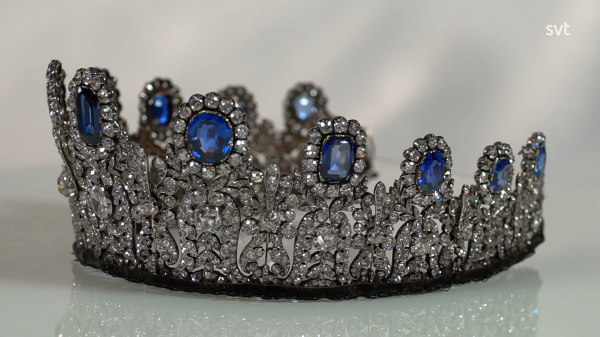 |
| The Leuchtenberg Sapphire Tiara (SVT) |
The parure includes a number of impressive sapphire and diamond pieces, including the tiara, a necklace, a pair of earrings, a brooch, and a set of hair ornaments. The tiara features diamond floral motifs topped by eleven sapphire and diamond clusters. We’ve talked before about the inflexibility of some tiaras, but this one is the polar opposite. The base is so flexible that the tiara lays completely flat when stored, making it both easy to transport and easy to wear.
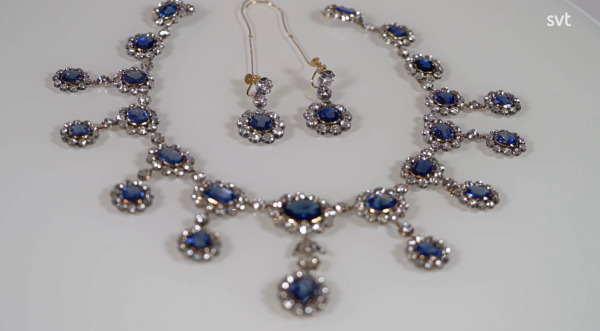 |
| The necklace and (new) earrings from the sapphire parure (SVT) |
The set has been altered slightly over the years. Originally, the sapphire and diamond clusters atop the tiara were removable and could be replaced with a set of pearls. Today, the sapphires are fixed permanently on the tiara, and the pearls have been used in other pieces of jewelry. The original earrings from the suite were disposed of by Queen Victoria of Sweden, who never wore earrings. Later, a new pair of earrings was created using two of the set’s hairpins.
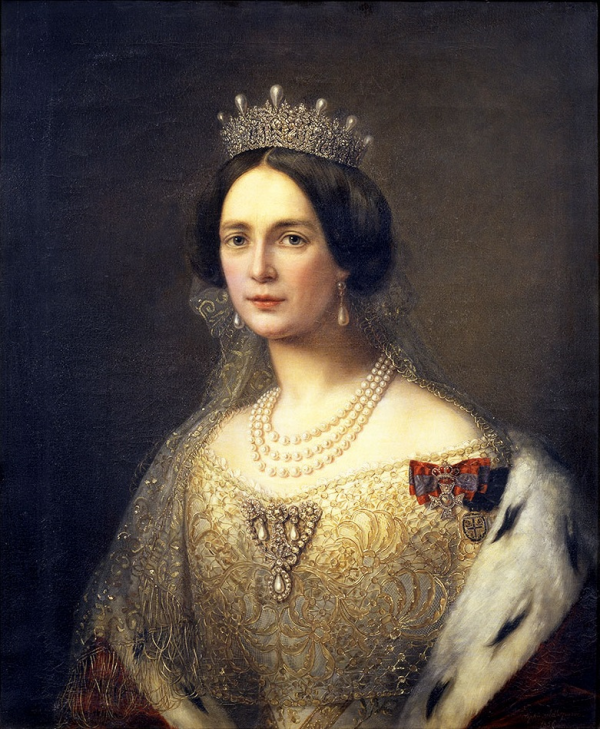 |
| Queen Josefina of Sweden and Norway wears the original alternate pearl setting of the Leuchtenberg Sapphire Tiara in a portrait painted by Sofia Adlersparre, ca. 1856 (Wikimedia Commons) |
The Leuchtenbergs had several children, many of whom made successful dynastic marriages. One of their daughters, Amélie, became Empress of Brazil, and inherited her mother’s diamonds and emeralds. The eldest, Joséphine, married the future King Oscar I of Sweden, eventually becoming Queen Josefina of Sweden. She’s the one who inherited her mother’s sapphires, and they’ve resided in the Swedish royal vaults ever since. For several generations, the gems passed through the hands of various Bernadotte family members. Josefina’s son, King Oscar II, inherited them from his mother in 1876. Five years later, Oscar and his wife, Queen Sofia, gave the parure to their new daughter-in-law, Victoria of Baden.
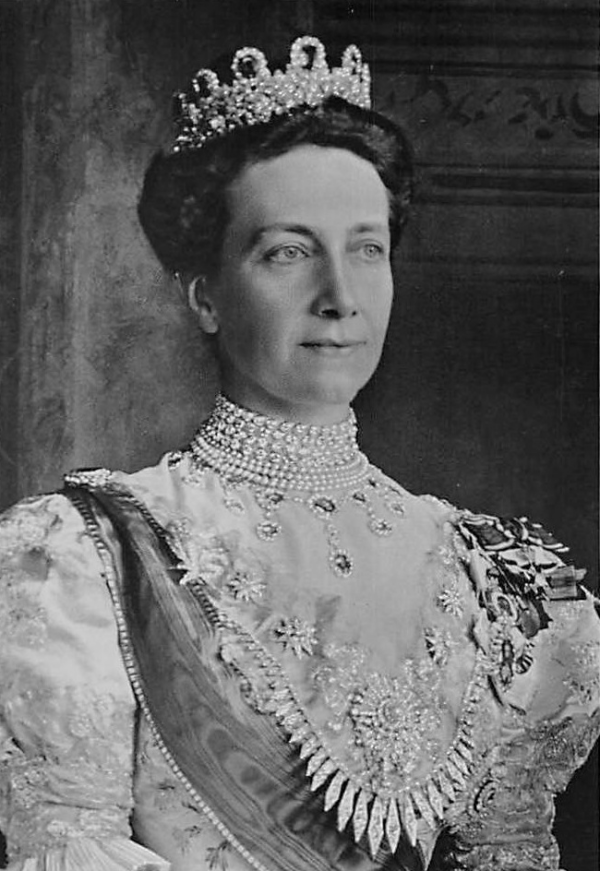 |
| Queen Victoria of Sweden wears the tiara, necklace, and brooch from the Leuchtenberg Sapphire Parure during the wedding celebrations for her son, the future King Gustaf VI Adolf, and Princess Margaret of Connaught in Windsor, June 1905 (Wikimedia Commons) |
Victoria wore the set (except for the earrings) regularly as crown princess and as queen, and she was photographed in the tiara and the rest of the parure. But rather than leaving the sapphires to any of her children or their spouses, Queen Victoria decided to preserve the set by bequeathing it to the family’s jewel foundation on her death in 1930. This is good for a couple of reasons — the main one is that the sapphires cannot be sold, but their presence in the foundation means that they are also available for more than one member of the family to wear.
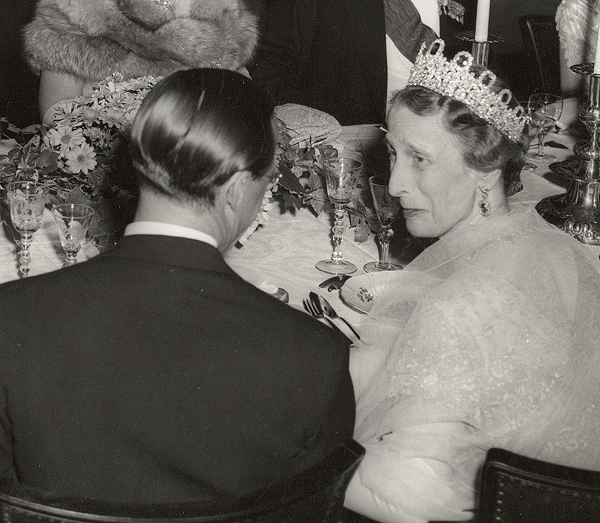 |
| Queen Louise wears the tiara and earrings from the Leuchtenberg Sapphire Parure during the Swedish state visit to the Netherlands, April 1955 (Anefo/Nationaal Archief/Wikimedia Commons) |
Even though they are theoretically available to all of the Bernadotte ladies, the sapphires have largely continued to be worn by the highest-ranking lady in the family. Queen Louise, the second wife of King Gustaf VI Adolf, made the sapphire tiara one of her signature pieces. After her death in 1965, the country was without a queen consort for more than a decade. During that time, the sapphires were worn by Princess Sibylla, the mother of the current king, who served as first lady for her father-in-law. The set was also worn by Princess Birgitta at the wedding of the present king and queen in 1976.
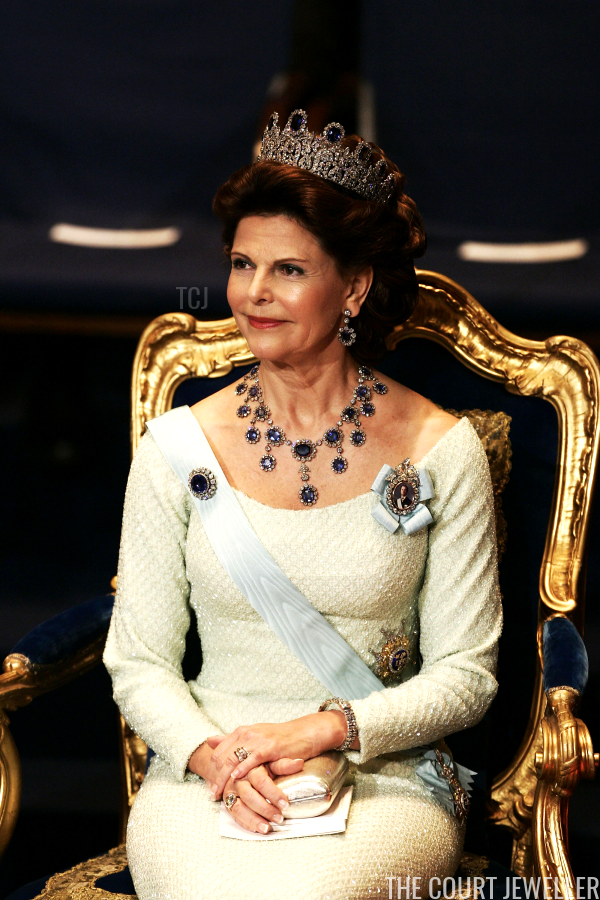 |
| Queen Silvia wears the tiara, earrings, necklace, and brooch for the Nobel Prize ceremony, December 2004 (Pascal Le Segretain/Getty Images) |
Since 1976, the sapphires have been used exclusively by Queen Silvia. The set is majestic, beautiful, easy to wear, versatile, and historic, so it’s easy to understand why it has become one of her most-used tiaras. It’s also one of the tiaras she wears frequently to the Nobel Prize ceremony and banquet, held annually on December 10 in Stockholm.
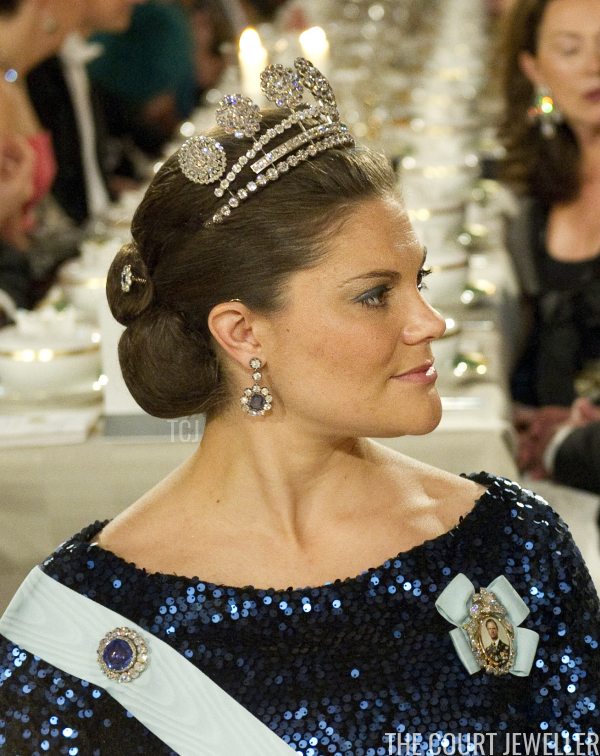 |
| Crown Princess Victoria wears parts of the parure at the Nobel Prize banquet, December 2011 (JONATHAN NACKSTRAND/AFP via Getty Images) |
Though Silvia has continued to be the sole wearer of the tiara, Crown Princess Victoria has worn parts of the parure. For the Nobels in December 2011, Victoria wore the earrings, brooch, and hairpins from the parure with the Diamond Six-Button Tiara.
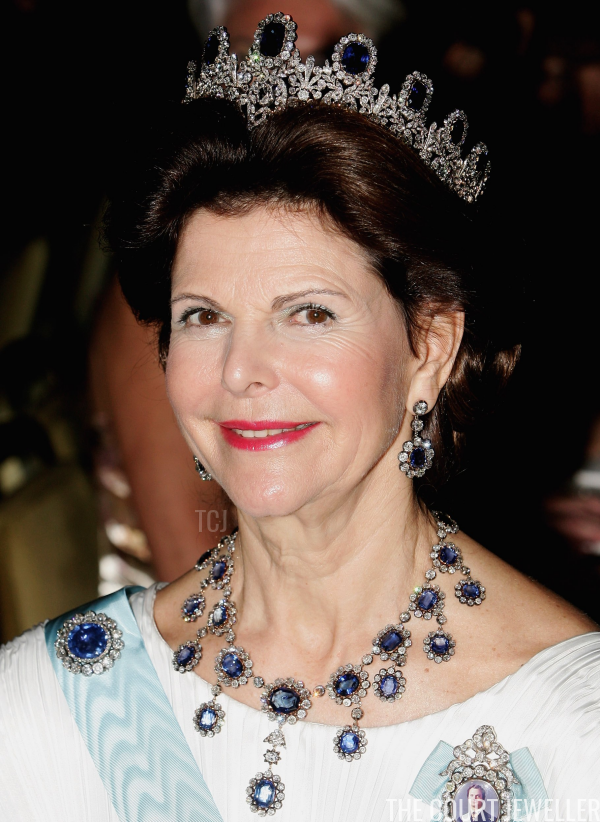 |
| Queen Silvia wears the sapphires for the Nobel Prize banquet, December 2006 (Pascal Le Segretain/Getty Images) |
In the recent royal jewelry documentary, Queen Silvia confirms that the sapphires are very easy to wear, especially as her hairdresser, Peter Hägelstam, developed a base for the tiara that allows it to be more comfortably secured to Silvia’s hair with pins. Silvia specifically mentions the sapphires as her personal favorite set of jewels from the Swedish vault.
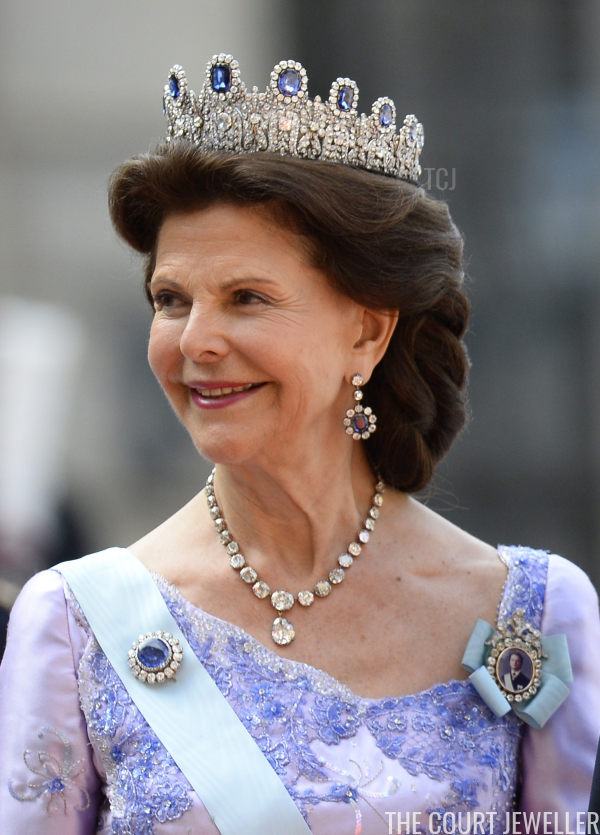 |
| Queen Silvia wears the tiara, earrings, and brooch from the sapphire parure at Prince Carl Philip and Princess Sofia’s wedding, June 2015 (JONATHAN NACKSTRAND/AFP via Getty Images) |
Queen Silvia wore the tiara, earrings, and brooch from the sapphire parure for one of the most important Swedish royal events of 2015: the wedding of her son, Prince Carl Philip. On that occasion, even amid the grand tiaras worn by other royal ladies, it definitely said, “I’m the queen!”
Leave a Reply